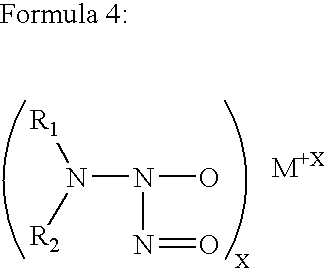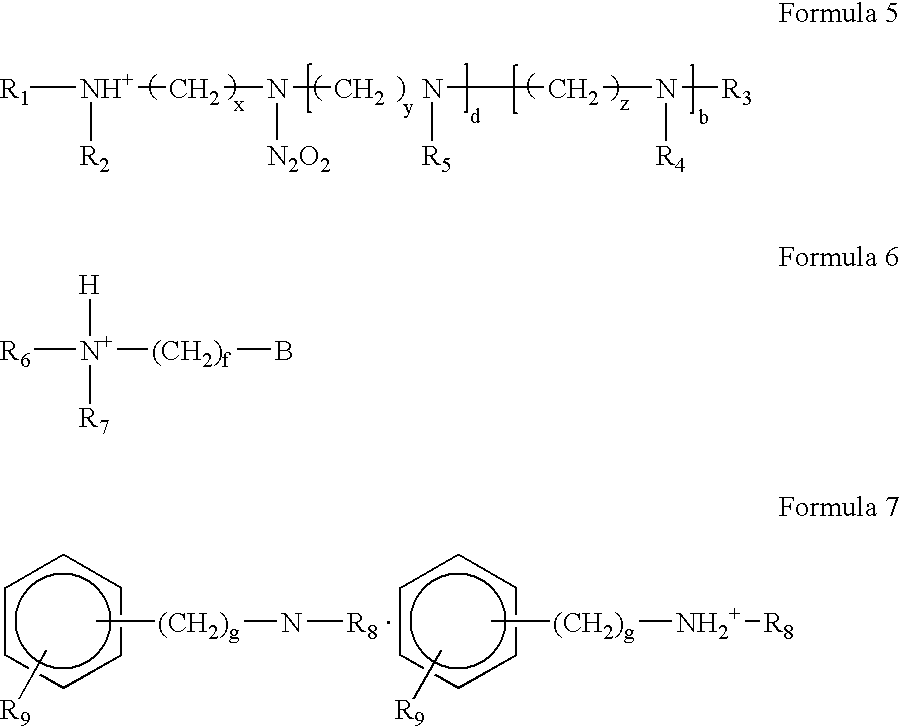Highly cross-linked, extremely hydrophobic nitric oxide-releasing polymers and methods for their manufacture and use
a nitric oxide and polymer technology, applied in the field of preparing nitric oxide releasing highly crosslinked, extremely hydrophobic polymers, can solve the problems of reducing the nitric oxide release rate. , to achieve the effect of preventing restenosis, high no loading capacity and long duration of no releas
- Summary
- Abstract
- Description
- Claims
- Application Information
AI Technical Summary
Benefits of technology
Problems solved by technology
Method used
Image
Examples
example 1
Polydiazeniumdiolation of Pentaethylene Hexamine-Derivatized Polydivinyl Benzene Micro-Beads using Acetonitrile (size: 5 μm, porosity: 100 Å)
In a 50 ml Parr® hydrogenation bottle was added 250 mg of pentaethylene hexamine-derivatized polydivinylbenzene micro-beads (size 5 μm, porosity: 100 Å) and 10 ml of acetonitrile. The bottle was attached to a NO apparatus and degassed by repeated cycles (×10) of pressurization / depressurization with N2 at 4 atmospheres. Next, the bottle was pressurized / depressurized with repeated cycles (×10) of NO at 4 atmospheres. The vessel was then filled with NO at 4 atmospheres and stirred at room temperature for 48 hrs. After 48 hrs. the bottle was purged of NO and pressurized / depressurized with repeated cycles (×10) of N2 at 4 atmospheres. The acetonitrile suspension of polydiazeniumdiolated pentaethylene hexamine-derivatized polydivinylbenzene micro-beads (size 5 μm, porosity: 100 Å) was then transferred to a 12 ml test tube and centrifuged in a Dynac...
example 2
Diazeniumdiolation of Pentaethylene Hexamine-Derivatized Polydivinyl Benzene Micro-Beads using a 6% Sodium Methylate Solution (size: 5 μm, porosity: 100 Å)
In a 15 ml pear-shaped flask was added 300 mg of pentaethylene hexamine-derivatized polydivinylbenzene micro-beads (size 5 μm, porosity: 100 Å) and 10 ml of a 6% sodium methylate solution. The flask was placed in a Series 4751 Parr® pressure vessel and degassed by repeated cycles (×10) of pressurization / depressurization with N2 at 10 atmospheres. Next, the vessel was pressurized / depressurized with repeated cycles (×3) of NO at 30 atmospheres. The vessel was then filled with NO at 30 atmospheres and stirred at room temperature for 48 hrs. After 48 hrs, the vessel was purged of NO and pressurized / depressurized with repeated cycles (×10) of N2 at 10 atmospheres. The flask containing the polydiazeniumdiolated pentaethylene hexamine-derivatized polydivinylbenzene micro-beads (size 5 μm, porosity: 100 Å) was then removed from the vess...
example 3
A Polymeric Blend Comprised of the Sodium Salt of Polydiazeniumdiolated Pentaethylene Hexamine-Derivatized Polydivinyl Benzene Micro-Beads (size: 5 μm, porosity: 100 Å) and Polyvinylchloride
In a KBr press was added 200 mg of polyvinyl chloride and 20 mg of the sodium salt of polydiazeniumdiolated pentaethylene hexamine-derivatized polydivinylbenzene (described in Example 2) and pressed using a hydraulic press to 12,000 psi. The resulting fragile pellet was placed on watch glass and cover with tetrahydrofuran. The solvent was allowed to slowly evaporate on the edge of a laboratory fume hood. The pellet which remained was briefly dried in vacuo and evaluated for its ability to release NO.
A sample consisting of approximately 25 percent of the pellet (0.51 mg) was immersed in phosphate buffer, pH 7.4 at 37° C., whereupon chemiluminescence-detectable NO evolved during a 14-day period of analysis. The total NO released was measured at 6.23×10−7 mole or 0.12 μmole / mg. By carefully plot...
PUM
| Property | Measurement | Unit |
|---|---|---|
| diameters | aaaaa | aaaaa |
| diameters | aaaaa | aaaaa |
| diameter | aaaaa | aaaaa |
Abstract
Description
Claims
Application Information
 Login to View More
Login to View More - R&D
- Intellectual Property
- Life Sciences
- Materials
- Tech Scout
- Unparalleled Data Quality
- Higher Quality Content
- 60% Fewer Hallucinations
Browse by: Latest US Patents, China's latest patents, Technical Efficacy Thesaurus, Application Domain, Technology Topic, Popular Technical Reports.
© 2025 PatSnap. All rights reserved.Legal|Privacy policy|Modern Slavery Act Transparency Statement|Sitemap|About US| Contact US: help@patsnap.com



